Zircon sand is a rare metal ore. Due to its high melting point (2400°C), high hardness, excellent physical and chemical properties such as corrosion resistance and radiation resistance, it has been more and more widely used, so its economic value and strategic value are extremely high. At present, the ceramic industry will enter a recovery cycle in the context of economic recovery, thereby driving a new round of demand for the zirconium industry. Zircon sand can also be used in 3D printing, power batteries, photovoltaic power generation and other fields, and the demand for zircon ore in emerging markets is rising. With wide application, the gap between supply and demand has widened.
When processing zircon sand, due to the complex and diverse composition of minerals, the particle size is uneven. The beneficiation process brings a lot of interference and influence, resulting in the poor grade of the concentrate obtained from the zircon sand extracted from many raw materials, resulting in the current situation of low recovery rate. We has more than 35 years of mineral processing experience and a professional engineer team. Equip you with the highest quality zircon sand separation solution and equipment to maximize useful minerals’ recovery and achieve high quality and economic benefits.
About Zircon Sand
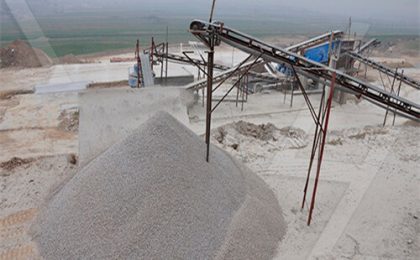
Zircon ore, also known as zircon sand (ZrO2) or zircon stone (ZrSiO4), is a mineral mainly composed of zirconium, silicon and oxygen crystallized from magma when igneous rocks are formed. Zircon also occurs in dikes and metamorphic rocks. It belongs to the tetragonal crystal system, often in the form of well-developed cone-shaped small square columns, and also in irregular granular shape. Brittle, shell-like fracture, is a high-quality refractory material. Its zirconium ore has super corrosion resistance, high temperature resistance, and nuclear radiation resistance, and can be used in nuclear reactors and aerospace. It can be called the rich and handsome in the material industry and the king of the metal industry!
According to their genesis, zircon deposits can be divided into vein ore and placer. Zircon deposits with industrial mining value are mainly Shi placer deposits. There are alluvial, residual, and seaside placer, among which beach sand has industrial mining value. The zircon in the parent rock along with monazite, ilmenite, rutile, garnet, xenotime, etc. impacts on the coast to form sedimentary deposits. It is obtained after separation by water separation, electric separation, magnetic separation and other beneficiation processes.
Zircon Sand Separation Solutions
Zircon sand beneficiation is the process of removing impurity minerals in zircon sand ore and increasing the content of zircon sand. The commonly used zircon sand beneficiation process is a composite beneficiation process, including gravity separation, flotation, electric separation, magnetic separation and other different processes. The main purpose is to remove the impurities associated with zircon sand, so that it can be effectively purified.
1. Zircon Sand Gravity separation
It is the most commonly used beneficiation method for zircon sand ore. The proportion of zircon sand is relatively large, and the proportion of impurities associated with it is relatively small. Moreover, the content of zircon sand in seaside placer is low, so in the roughing stage, most of the beneficiation of zircon sand adopts the energy-saving and efficient gravity separation method. Zircon placer is roughed and enriched by gravity separation equipment such as jig concentrators and shaker tables. Abandon the gangue associated with zircon sand, such as quartz, feldspar, biotite, and other impurities.
2. Zircon Sand Flotation
It is also a method for separating gangue and impurities associated with zircon sand. Commonly used collectors are fatty acids, regulators are sodium carbonate, inhibitors are sodium silicate, activators are sodium sulfide, and heavy metal salts. Since there are many associated minerals in zircon placer, the flotation separation method requires designing a process and flotation system according to the specific composition of the minerals.
3. Zircon Sand Electric separation
The method is to use the difference in magnetic permeability between minerals to separate zircon sand from associated ores (ilmenite, hematite, chromite, cassiterite, rutile) and non-conductive minerals (zircon, monazite, garnet, apatite). The electro-separation method has high requirements on the minerals, and the minerals usually need to be deslimed, classified, and dried before the mineral processing.
4. Zircon Sand Magnetic separation
The method is used to separate the magnetic substances in the rough concentrate of the zircon sand gravity separation, and the wet magnetic separator is commonly used for the zircon sand separation. Designing a reasonable magnetic field mechanism and magnetic field strength according to the specific mineral composition has a great effect on the magnetic separation of zircon sand.
Zircon Sand Separation Equipment
Shaking table
The separation principle of the shaking table is based on the different gravity of the ore particles with different densities and particle sizes. There is a magnetic strip on the back of the bed in the mining area, which strengthens the downward force of magnetic particles (such as ilmenite). The effect is equivalent to increasing the density of the magnetic particles, so that the magnetic particles are discharged closer to the end of the concentrate. Non-magnetic particles are largely unaffected. For the separation of zircon sand medium ore, it directly reduces the valuable components in the discharged tailings.
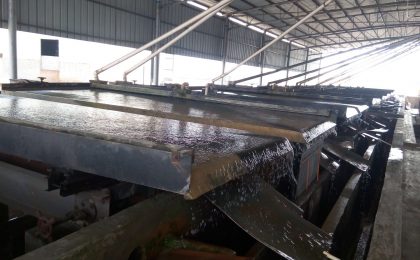
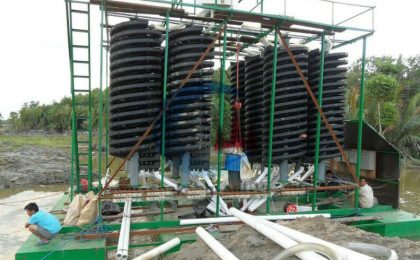
Spiral Chute
The spiral chute is suitable for sorting iron ore, ilmenite, chromite, pyrite, zircon, rutile, monazite, phosphoretite, etc. with a particle size of 0.3–0.02 mm. It is an equipment that combines the characteristics of spiral concentrator, shaking table and centrifugal concentrator, and is the best equipment for mining and beneficiation. Especially the placer mining on seashore, riverside, sandy beach and creek is more ideal.
Magnetic separator
Magnetic minerals in heavy minerals include ilmenite, hematite, chromite, garnet, biotite, monazite and so on. Iron selection is carried out by a simple and effective magnetic separation method. Zircon is a non-magnetic or weakly magnetic mineral (the iron contained in zircon in some deposits is weakly magnetic). Magnetic separation is divided into dry type and wet type. Dry magnetic separation needs to heat and dry the selected materials, and then sort them after pretreatment such as classification. The wet strong magnetic field magnetic separator has a wide separation particle size, and the lower limit of the particle size can reach 20um. Therefore, it is more appropriate to use wet magnetic separator when the particle size of zircon is fine.
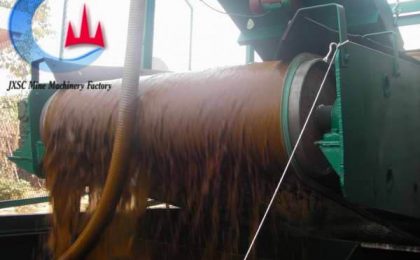
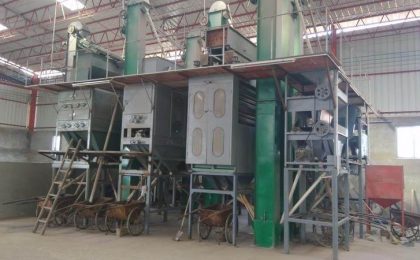
Electric separator
The electro-separation method is based on the difference in mineral conductivity. When minerals pass through the high-voltage electric field of the electric separator, due to the different conductivity of the minerals, the electrostatic force acting on the minerals is also different, so the minerals can be separated.
In modern ore beneficiation plant on site, jigs, shakers, and spiral chutes are widely used for roughing, and magnetic separation, electrostatic separation, foam flotation and gravity separation are used for beneficiation. Therefore, the commonly used complete set of zircon sand beneficiation equipment generally includes crushers, ball mills, classifiers, jig machines, shaking tables, magnetic separators, flotation machines, dryers and other equipment. The specific zircon sand beneficiation process and equipment configuration need to be determined according to the mineral composition and properties of zircon sand.